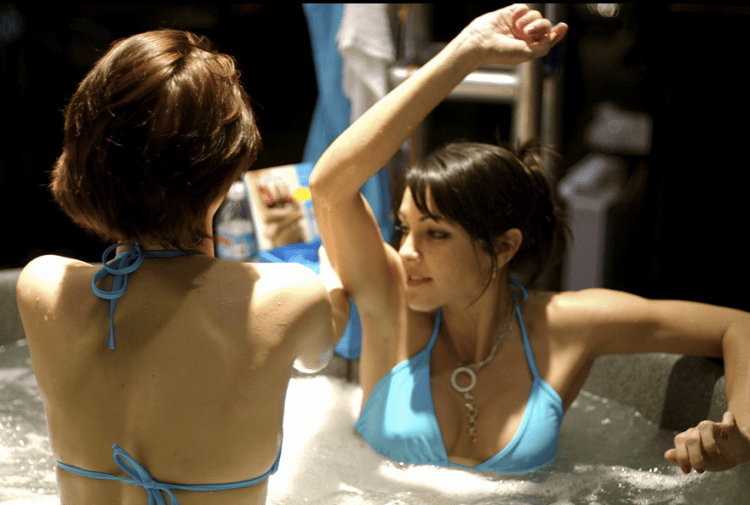LAS VEGAS — “They won’t even approach me. It’s almost like they’re scared.”
The ravishing brunette in front of me is in her early to mid 20s. Her makeup is flawless; her hair is a case study in the perfect Victoria’s Secret-model blowout. She, along with hundreds of other models on the 2014 International CES show floor, is a variation on the definition of physical perfection.
On condition of anonymity, she’s tentatively talking to me about her experience at CES. She’s a University of Nevada, Las Vegas biology major and is married. She, like the majority of her peers, was booked to work the show through a modeling agency.
Why, aside from her obvious good looks, is she modeling? “I don’t have to work a 9-to-5, so it doesn’t affect my schoolwork.”
It makes total sense. She’s smart enough to take advantage of what her mama gave her and use it to improve her life, career, and future. She chooses, in a specific time and space, to morph into a well-informed, friendly object, more often photographed than spoken to, at countless conventions and other events throughout the always-full calendar of Las Vegas.
I ask her how the CES conventioneers treat her. As opposed to attendees at other shows, she says, most of the men and women here are shy but respectful. Would she classify them as desperate nerds? She laughs a bit nervously. “I guess so,” she says.
“And then you get the creepers who like to take photos without asking.”
That’s a pretty common complaint among the models. But they also seem to get why that happens: pure, bone-shaking intimidation.
Even I, a lady reporter, feel nervous walking up to these women. Even though I see them as well-rounded people with wonderful senses of humor, friendly attitudes, and formidable brains, their startlingly pretty appearances manage to form roadblocks of social anxiety. I can’t help but stammer and speak in a string of Freudian slips, awkward malapropisms, repetitious salvos, and incomplete sentences.
If I, a lady reporter who falls just on the lucky side of cute, have sweaty palms about approaching the models of CES, imagine how the male attendees must feel.
Again and again, the models tell me the same thing: As compared to other cons, CES is awash with nervous men. They don’t approach except to shyly ask for a photo.
One has to wonder: If CES attendees feel intimidated by a booth spokesperson, why is that spokesperson chosen to do the job? Why not let the models dress down, adopt girl-next door makeup, and actively demo the products instead of standing around in heels waiting for the next photo opp?
The four-time CES model I speak to next has some truly spectacular photo-opp stories. When attendees get courageous, they get out-and-out kinky.
“You kind of wonder where your picture’s going to end up,” she says. “I had someone ask to take a picture just of my feet. One guy asked to take a picture of me while I was wearing nude fishnets. Then, after he took the photo, he wanted to talk to me about his pantyhose fetish.”
We laugh, and I observe that she’s become a sort of sex therapist by virtue of her presence as a sexualized entity at the show.
“I do promotional modeling full-time,” she tells me, “five to 60 hours a week. During convention season, there’s a job every day.”
The CES makeup this year has shifted, she says. She estimates that three quarters of attendees are Asian businessmen — manufacturers, buyers, etc.
“It seems to be an older crowd this year,” she continues. “They’re more respectful. The younger ones in previous years used to ask for my number a lot.”
One of the most interesting women I spoke begins with a pitch — something I hoped for during these interviews.
“I guess you could call me a model-preneur!” she jokes. She’s actually familiar with VentureBeat, a tidbit that temporarily blows my mind. It’s a small world, after all.
“I love my techies,” she says. “I love seeing all the gadgets. I haven’t gotten to wander around yet. Maybe Thursday afternoon.”
She tells me that she’s a print model. She’s constantly flying around the world, living the hard-won, grueling model life.
“But I want to make my own app — for models.” We chat about the (actually really interesting) details, which I promise not to reveal in print, lest someone rip off the idea.
Some CES in the future, she plans to come back to the show floor to pitch her app to the other models. “We all know each other, you know,” she says.
During my show-floor travels, I confirmed my hypothesis that the so-called “booth babes” are worthy of so much more than objectification. But these women surprised me with some of their insights, namely that sexualizing them is bad for business.
A nameless, hot object is something you want to look at. But to get to know the person and the product she represents, you have to see her as a person.
I hope, in spite of the realities around me, that a main CES trend in years to come will be the tapering-off of the “booth babe” and the rise of a new kind of model on the trade show floor.
VentureBeat's mission is to be a digital town square for technical decision-makers to gain knowledge about transformative enterprise technology and transact. Learn More

